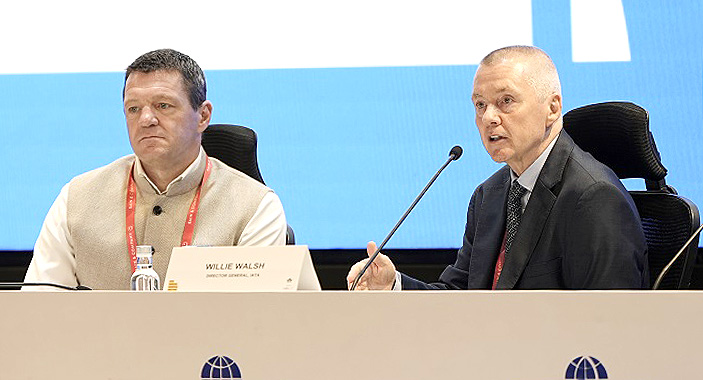
81st IATA AGM: News Coverage
Despite tariffs, 2025 should be more profitable year for airlines than 2024
June 3rd 2025
The International Air Transport Association (IATA) announced updates to its 2025 airline industry financial outlook, showing improved profitability over 2024 and resilience in the face of global economic and political shifts. Read More » IATA predicts 2025 net profits at $36.0 billion, improved from the $32.4 billion earned in 2024, but slightly down on the previously projected $36.6 billion. Asian carriers are predicted to book a USD4.9 billion profit. Net profit margin at 3.7%, improved from the 3.4% earned in 2024 and the previously projected 3.6%. Total revenues are at a record high of $979 billion (+1.3% on 2024, but below the $1 trillion previously projected). In 2025, the global margins will be USD7.2 per passenger, compared to USD6.8 in 2024. Asia-Pacific carriers’ margins this year are predicted to be USD2.6 per passenger, compared to USD2.3 last year. “The first half of 2025 has brought significant uncertainties to global markets. Nonetheless, by many measures, including net profits, it will still be a better year for airlines than 2024, although slightly below our previous projections. The biggest positive driver is the price of jet fuel, which has fallen 13% compared with 2024 and 1% below previous estimates. Moreover, we anticipate airlines flying more people and more cargo in 2025 than they did in 2024, even if previous demand projections have been dented by trade tensions and falls in consumer confidence. The result is an improvement of net margins from 3.4% in 2024 to 3.7% in 2025. That’s still about half the average profitability across all industries. But considering the headwinds, it’s a strong result that demonstrates the resilience that airlines have worked hard to fortify,” said Willie Walsh, IATA’s Director General.
• Supply chain delays in aircraft deliveries continue to have negative impacts on airlines
The International Air Transport Association (IATA) data shows the aircraft backlog exceeds 17,000, compared with 10,000-11,000 pre-pandemic, with an implied wait time of 14 years. Supply chain issues have had significant negative impacts on airlines: driving-up leasing costs, increasing the average fleet age to 15 years (from 13 in 2015), cutting the fleet replacement rate to half the 5-6% of 2020, and reducing the efficiency of fleet utilization (using larger aircraft than needed on some routes, for example). In 2025, 1,692 aircraft are expected to be delivered. Although this would mark the highest level since 2018, it is almost 26% lower than year-ago estimates. Further downward revisions are likely, given that supply chain issues are expected to persist in 2025 and possibly to the end of the decade. The supply chain issues were also affecting the deliveries of the engines. Engine problems and a shortage of spare parts have caused record-high groundings of certain aircraft types. The number of aircraft younger than 10 years in storage is currently more than 1,100, constituting 3.8% of the total fleet compared with 1.3% between 2015 and 2018. Nearly 70% of these grounded aircraft are equipped with PW1000G engines, IATA said, adding that if states exit from a multilateral agreement exempting aircraft from tariffs, supply chain constraints and production limitations could be further aggravated. “Manufacturers continue to let their airline customers down. Every airline is frustrated that these problems have persisted so long. And indications that it could take until the end of the decade to fix them are off-the-chart unacceptable!” said Walsh.
• North Asia is in forefront of digitalization
Several ongoing initiatives place the North Asia region at the forefront of industry digitalization, Dr. Xie Xingquan, IATA Regional Vice President, North Asia, said during a presentation at the 81st IATA Annual General Meeting (AGM) and World Air Transport Summit (WATS). Hong Kong, Beijing, and Shanghai airports deployed One ID. Furthermore, in 2024, Cathay Pacific Airways, together with Hong Kong International Airport (HKIA) and Tokyo Narita Airport, successfully executed proof of concept (POC), demonstrating a fully digital travel experience. Current priorities for the region are the adoption of One ID standards, participation in the IATA networking group, and harmonizing the regulations. In the air cargo sector, the carriers in the region conducted more than 10 pilots of ONE Record. In November 2024, IATA allowed the use of Digital Renminbi for travel agents’ remittance. Reconciliation and payment to airlines are planned to be launched in 2025. Although so far there has not been much use of the new currency, it is an important option with many possible benefits, Dr. Xie told Orient Aviation Daily Digest.
• Luis Gallego chairs IATA Board
The International Air Transport Association (IATA) announced that Luis Gallego, CEO of International Airlines Group (IAG), has assumed his duties as Chair of the IATA Board. His one-year term began at the conclusion of the 81st Annual General Meeting in New Delhi, India, on June 2, 2025.